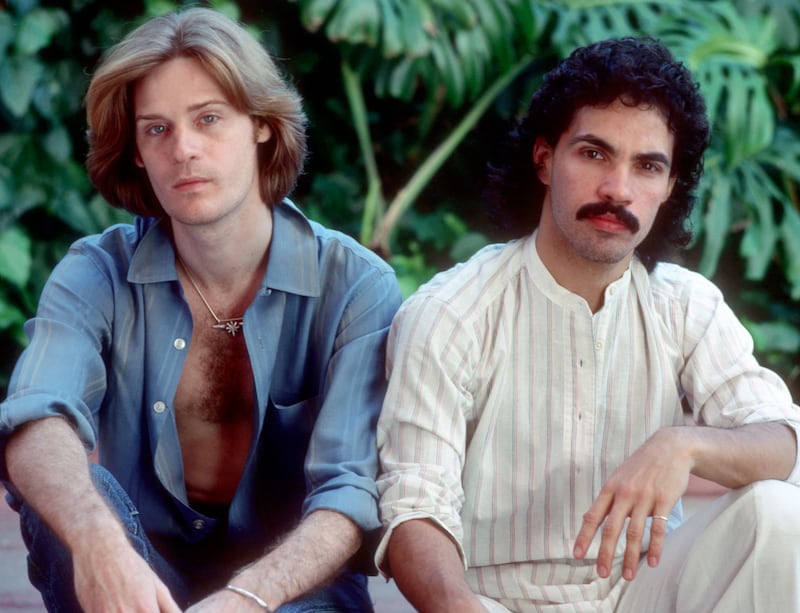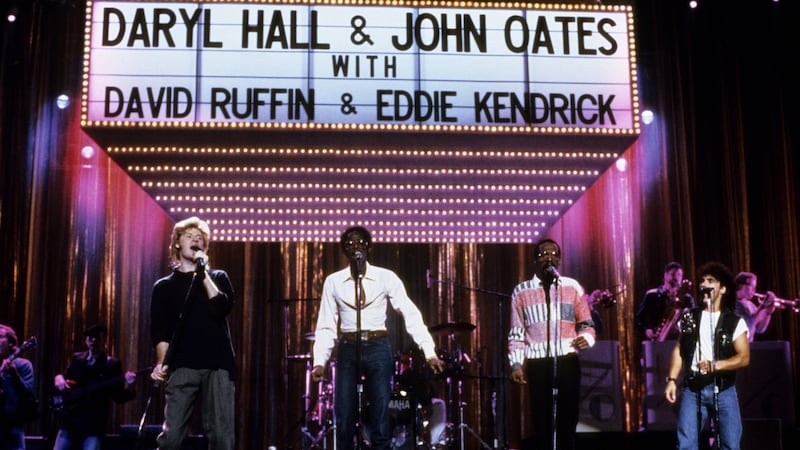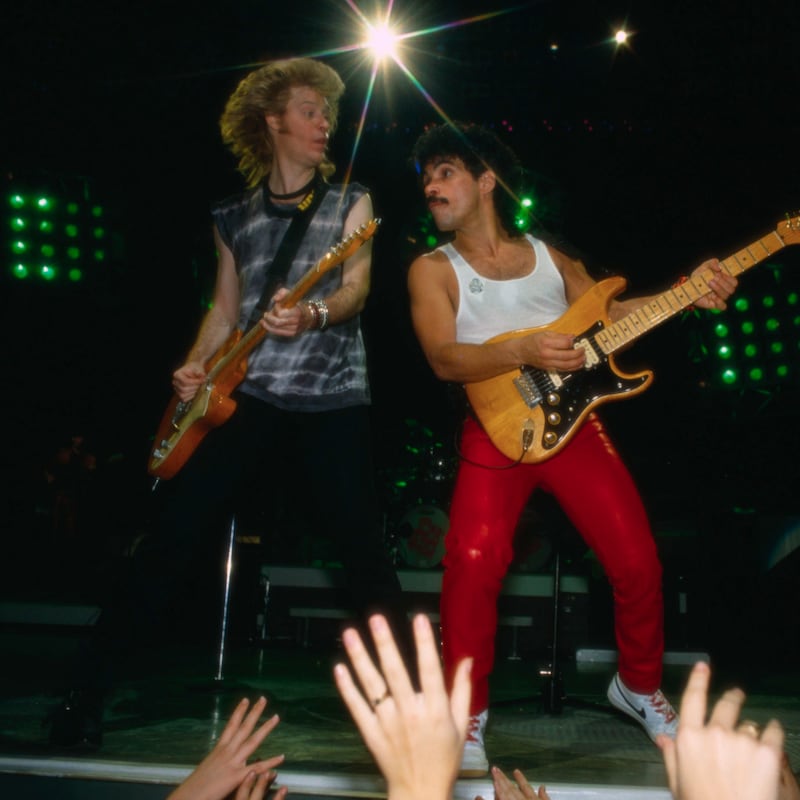I'm half an hour into my interview with John Oates when he insists I need to look at YouTube as a matter of extreme urgency. "You've never seen this?" he says, incredulous, down the phone from his home in Nashville. "My friend, I don't know you very well, but you're missing a great moment in music history. Your life will change. Your perceptions of us will never be the same again."
This is the 1973 video that Daryl Hall and John Oates made for She's Gone, the standout track from their album Abandoned Luncheonette, and a staple of their live sets to this day. It's certainly striking viewing. The pair are slumped, poker-faced, in armchairs ("That's the furniture from our apartment," notes Oates). Daryl Hall is resplendent in a pair of platform sandals; Oates is wearing a bow tie and dress shirt with no sleeves.
A woman walks in front of the camera – this, Oates informs me, is the songwriter Sara Allen, Hall’s former partner and the coauthor of a string of Hall & Oates hits – followed by a man with a moustache wearing a sparkly devil costume. The latter helps Oates into a penguin-suit dinner jacket with an enormous pair of flippers attached to the arms, in which he listlessly mimes a guitar solo. All three march around the armchairs together, then walk off.
The pair met while fleeing a fight that had broken out in a Philadelphia dance hall in 1967. Oates was a folkie, fond of country and blues. Hall had served a remarkable musical apprenticeship on the city's soul scene
Perhaps understandably, the local TV show for which they recorded the video declined to show it (“They called our record company and said: ‘Who do these guys think they are? They are mocking us! They will never appear on TV again!’”), but you can see why Oates has chosen to exhume it. For one thing, it points up the sheer oddness of Hall & Oates in the 1970s, of which more later. And for another, as Oates suggests, it helps to explain why the duo so successfully navigated the 1980s. Many of their 1970s peers struggled in the new world of music videos and synthesisers, but Hall & Oates thrived: if you’d been filmed marching around a set of armchairs wearing flippers, you were ready for MTV.
The MTV years were the commercial apex of Hall & Oates’s career. In the 1980s they had five consecutive platinum albums and five US No 1 singles, a relentless succession of the kind of impermeable hits that continue to rack up millions of streams and ensure that the duo still play arenas: Maneater, Out of Touch, I Can’t Go for That (No Can Do), Private Eyes.
As if to prove the point about their vast continued popularity, they are reissuing the 7in of their 1981 single You Make My Dreams. It wasn’t even released as a UK single at the time, but it developed an afterlife because of its use in the 2009 film 500 Days of Summer: 12 years later it’s by far their biggest track. It was played after Joe Biden’s victory speech last November, a month after it notched up its one billionth global stream, a state of affairs that seems to baffle the duo.

Hall, primarily the singer, who is on the phone at home in New York state, suggests the song’s success has something to do with its “aggressive positivity”, but admits: “I’m not really sure, that’s the truth.” Oates, primarily the guitarist, offers a lengthy and eloquent discourse on the pangenerational appeal of classic rock, then shrugs: “It’s just a f**kin’ great groove and a simple, direct statement. I could have cut all the crap I just said and said that.”
They met while both fleeing a fight that had broken out in a Philadelphia dance hall in 1967. Oates was a folkie, fond of country and blues. Hall had served a remarkable musical apprenticeship on Philadelphia’s “very intense, very racially integrated” soul scene. As a teenager he was friends with the soft-soul bands the Delfonics and the Stylistics; at the city’s answer to Harlem’s Apollo, the Uptown Theatre, he hung out with the Temptations and Smokey Robinson.
When his own band, the Temptones, won a local talent competition, the prize was to record a single with producers Gamble and Huff, who would shortly change the face of pop with the symphonic soul and disco on their Philadelphia International label.
Ken Gamble attempted to lure Hall to the new label as an artist and writer, but he chose to move to New York with Oates. “We were trying to forge our own version of the Philly sound, and we thought that the only way we could do that was by separating ourselves from Gamble and Huff – they were doing what they were doing, and we wanted to do something different.”
We wanted to remain true to who we were, but we didn't want to ignore the zeitgeist of what was happening in our lives
They released their debut album in 1972, but, from the outside at least, the next eight years of their career look like fascinating chaos. They had huge hits – the aforementioned She’s Gone, Sara Smile and Rich Girl – but they also had what Hall calls “a lethal ability to experiment”. One minute they sounded like a pop-soul band; the next they were releasing War Babies, produced by Todd Rundgren and backed by his prog band Utopia, home to songs with titles such as Johnny Gore and the “C” Eaters, and War Baby Son of Zorro. One minute they were on black R&B radio, the next they were on tour with Lou Reed in full Rock ’n’ Roll Animal mode (“a strange cat, man… his audience was even stranger, like… junkie-wannabes”).
They looked like regular 1970s singer-songwriters, but were absolutely plastered in makeup on the cover of their 1975 album, Daryl Hall & John Oates. “That was [the makeup artist] Pierre La Roche,” says Oates. “He was responsible for Bowie’s look, he worked with Jagger. I remember sitting with him at dinner; he was a very flamboyant character and he said: ‘I will immortalise you!’ It’s the only album cover anyone ever asks us about, so I guess he was right.” In 1977 Hall made Sacred Songs, an Aleister Crowley-inspired solo album, with Robert Fripp, which so horrified their record label, RCA, that it refused to release it for three years.
At least part of the problem was that, for all their Philadelphia roots and their LA recording sessions, they were spending their spare time hanging out on New York’s downtown 1970s music scene. “The New York Dolls, Patti Smith, Television – it was all happening,” says Oates. “I was out every night, going to the Mercer Arts Centre and Max’s Kansas City… We couldn’t avoid the influence of it. We wanted to remain true to who we were, but we didn’t want to ignore the zeitgeist of what was happening in our lives. And so that’s what we tried to do.”

Both agree that they truly hit paydirt when they were allowed to produce themselves and record with their live band: the result was 1980’s Voices, from whence You Make My Dreams and the US No 1 Kiss on My List sprang. In the late 1970s, Hall had been one of the few straight white artists to publicly call out the Disco Sucks movement (“Because I straddled the line, because of my background, I knew it for what it was: a racist thing, totally racist”). On Voices, he and Oates minted a pop style that was equal parts soul and new-wave rock, a pretty ballsy move in the pre-Thriller United States of 1980, where the genres were sharply divided. Certainly, Michael Jackson took an interest, later telling Oates he loved to dance to I Can’t Go for That, and that its bassline inspired Billie Jean.
“One of the things I don’t think we get full credit for is opening up the minds of commercial radio for that possibility,” says Oates. “We had our early success with black radio – the African-American community had been as big a part, if not a bigger part of our success as anything. So to us it was normal, that was the music we made, it appealed to a wide variety of people. I think we opened the door to more acceptance of what they defined as crossover music.” He sighs. “It’s all bullsh*t, those definitions, but nevertheless.”
The pair’s zenith may have come in 1985. They were asked to headline the reopening of the Apollo in Harlem, and insisted they would only perform if David Ruffin and Eddie Kendricks of the Temptations shared the stage: a few weeks later, Ruffin and Kendricks also shared Hall & Oates’s slot at the US leg of Live Aid. They began to feel they had achieved all they wanted to achieve.
I got divorced, sold everything I owned, moved to Colorado and started my life over in the mountains
Hall talks about the Apollo gig “completing the circle ... We felt like we had gone all the way around”. Oates clearly enjoyed their success in time-honoured rock-star style – he took up motor racing and began flying the duo to gigs in his own plane – but concedes that he found “the act of becoming far more interesting than the victory lap”.
After 1990’s tellingly titled Change of Season, they more or less walked away: Hall & Oates have released only four albums in the past 30 years. “We almost felt, like, what could possibly be the upside of where we are now?” says Oates. “If we release another record and it doesn’t go to No 1, is that a failure? We just felt like we needed something else. I personally needed to step away from writing, recording, touring in order to do that. I got divorced, sold everything I owned, moved to Colorado and started my life over in the mountains.”
He returned to his musical roots, playing country and folk, while collaborating with everyone from Dan the Automaton and Prince Paul’s hip-hop duo Handsome Boy Modelling School to The Bird and the Bee, super-producer Greg Kirsten’s indie band. It’s evidence, like the steadily declining age of audiences whenever Hall & Oates chose to tour together, that the duo’s critical stock had begun rising dramatically in the decades since their 1980s hits.

Hall, meanwhile, worked with the funk duo Chroma and appeared on the UK dance act Nero’s chart-topping debut album, and started Live from Daryl’s House, a YouTube series with a wildly eclectic list of guest performers that has proved immensely successful. He says he started it, with a certain weird prescience, after some Hall & Oates shows were cancelled as a result of 2003’s Sars epidemic. “I thought, What if this happens on a larger scale? Maybe I should figure out a way, if there ever comes a point where I can’t travel, that I can bring the world to me.”
He thinks the sheer range of guests involved – soul legends, singer-songwriters, rappers, rock bands – helps explain, "maybe for the first time", where he and indeed Hall & Oates were coming from. "Not easy to peg, not easy to categorise," he says. "I blame myself, really, more than anybody, more than John. Live From Daryl's House is a way I can explain that musical language, where I can have all these completely different musical styles and swim in any of those waters. And that sort of explained me. Before that, I absolutely think people were confused." – Guardian
You Make My Dreams, by Daryl Hall and John Oates, is released by CMG












